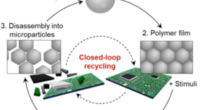Researchers at the John Innes Centre have used a powerful technique called transient combinatorial expression to reconstruct the pathway to producing valuable saponins in the plant Nicotiana benthamiana. Saponins are being used as adjuvants in vaccines, boosting the potency of a vaccine and enhancing the host immune response. The discovery of the biosynthetic pathway will enable researchers to develop bespoke saponin-based adjuvants with a diverse spectrum of immune-stimulating properties. Until recently, the only adjuvants in clinical use were insoluble aluminum salts or oil in water emulsions containing squalene, an organic compound obtained from shark liver. Saponins, natural surfactants used in veterinary medicine for a century, have been unsuitable for human use due to poor tolerability, but the breakthrough by the John Innes Centre could change that. The team has partnered with Plant Bioscience Limited (PBL) to scale up production and commercialize the research. The COVID-19 pandemic has increased the demand for lifesaving vaccines, and the use of saponins from the soapbark tree, Quillaja saponaria, has the potential to produce more potent, affordable, and sustainably sourced vaccines.
The Chilean soapbark tree, Quillaja saponaria, has been used in the food and drink industry for decades as a source of QS saponins, which are molecules used as foaming agents. More recently, these molecules extracted from the tree’s bark have been used as adjuvants in vaccines, playing a critical role in enhancing the host immune response and boosting the potency of a vaccine. In fact, saponins obtained from the soapbark tree are currently used as adjuvants in vaccines protecting people against COVID-19, shingles, and malaria.
While the direct sourcing of QS saponins from the tree is currently done at a much smaller scale than the food and drink industry, vaccine manufacturers are working to reduce the environmental impact and improve sustainability of sourcing these important resources. Researchers at the John Innes Centre have made a significant breakthrough in this area by using a combination of genome mining and bioengineering techniques to produce saponin-based vaccine adjuvants in the laboratory without harvesting material directly from trees.
By sequencing the genome of Quillaja saponaria and using powerful computational gene-mining tools, the researchers identified a biosynthetic pathway of 16 genes responsible for saponin biosynthesis. These genes and enzymes act as an instruction manual for future adjuvant bioengineering. The identification of a further three enzymes resulted in a complete biosynthetic pathway to the saponin QS-7, a notoriously difficult molecule to purify from soapbark tree, but one that is included in a vaccine adjuvant with proven clinical efficacy.
Dr. James Reed, the first author of the study and postdoctoral researcher at the John Innes Centre, notes that these are complex molecules that have historically thwarted attempts to synthesize them at scale using chemistry in the lab. However, with the discovery of the core set of genes responsible for the biosynthesis of QS saponins, the researchers have taken a major step forward in addressing this problem.
The use of soapbark tree saponins in vaccine adjuvants not only has the potential to produce more potent vaccines but also more affordable and sustainably sourced ones. The soapbark tree has already shown its usefulness in protecting against various diseases, and with this new breakthrough, it may soon be used to protect against even more.
Researchers at the John Innes Centre have reconstructed the pathway to producing valuable saponins, including QS-21, a potent adjuvant and key component in human vaccines, using a rapid and powerful technique called transient combinatorial expression in the plant Nicotiana benthamiana. The levels of saponins produced in this study equate to amounts normally obtained from the leaves of the soapbark tree rather than its bark, which is a significant step forward in reducing the environmental impact and improving the sustainability of sourcing these important resources. The team has partnered with Plant Bioscience Limited (PBL, Norwich UK), who are leading on the commercialisation of the research and are now looking to work with commercial and academic partners to scale up these quantities further.
The COVID-19 pandemic has demonstrated the huge demand for lifesaving vaccines, and with this breakthrough, researchers now have the instruction manual which has enabled them to decode how the tree makes these potent medicinal molecules. This opens the possibility of producing known and new-to-nature saponin-based vaccine adjuvants optimized for immunostimulant activity and suitable for human applications in a rapid transient plant expression system.
Until recently, the only adjuvants in clinical use were insoluble aluminum salts or oil in water emulsions containing squalene, an organic compound obtained from shark liver. As natural surfactants, saponins have been used in veterinary medicine for a century. However, these adjuvants have been unsuitable for human use due to poor tolerability. A vaccine containing a saponin-based adjuvant has been approved for use in humans. QS-7 and QS-21 are included in a complex mix of saponins formulated as Matrix-M adjuvant in the Novavax COVID-19 vaccine.
Knowledge of the biosynthetic pathway will enable researchers to develop bespoke saponin-based adjuvants with a diverse spectrum of immune-stimulating properties. Described as hidden helpers, vaccine adjuvants are immunostimulatory substances that are added to some vaccines to boost the immune response, doing so by inducing strong antibody and T-cell responses.
Don’t miss interesting posts on Famousbio










